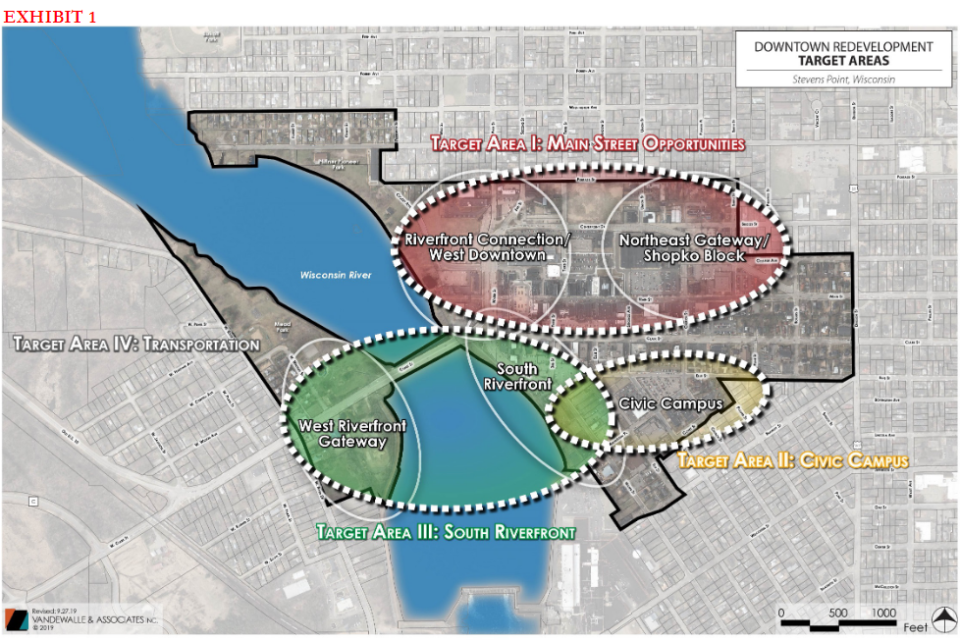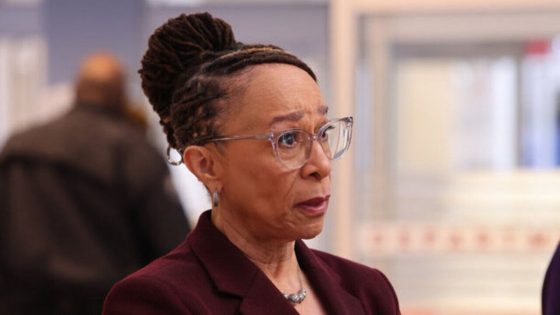STEVENS POINT − Stevens Point commission and council members approved an overall vision for the city’s downtown area Tuesday evening at a combined meeting.
A draft of the Downtown Targeted Area Master Plan, dated April 25, 2024, was presented by Vandewalle & Associates, a Madison-based planning and redevelopment firm that has worked with the Redevelopment Authority of the city of Stevens Point to create a fuller vision for the downtown area. According to the plan shared with the Common Council, Redevelopment Authority, Plan Commission, Transportation Commission and Park Commission at the Tuesday meeting, the plan looks at a long-term vision and high-level recommendations. It is meant to be a framework with guidelines for planning and future decisions.
At Tuesday evening’s meeting, Brian Munson and Jackie Mich from Vandewalle reviewed the plans, how they were formed and the opportunities ahead for the downtown area.
What is a Downtown Targeted Area Master Plan?
The plan itself is a big-picture look at what the downtown area could look like. Specific projects within the area would still require future development plans and approvals as usual. Vandewalle looked at untapped markets and opportunities to identify changes Stevens Point could choose to make.
Mich said one of the considerations in creating the Downtown Targeted Area Master Plan was to look ahead to what economy Stevens Point wants in the future. Success comes from resiliency, focusing on multi-faceted employment opportunities, housing and education. It also depends on vibrancy, creating entertainment and recreation, and it depends on diversity with a mix of public and private spaces, diverse events and a variety of options for residents, employers and students, she said.
The city’s existing Downtown Redevelopment Plan was adopted in 2008. The city has used it as a conceptual plan for potential redevelopment within the downtown area. The downtown area has significantly changed since then. The introduction and background of the plan sent to city officials and commission members said the plan aims to set vision and strategy for the next 10 to 20 years, looking ahead to what the city could look like in 50 or 100 years.
Establishing priorities like the city’s land use, transportation needs, parks, open spaces and potential development projects are fundamental in overall vision. The plan focuses on projects that could encourage reinvestment and revitalization of the area instead of planning out each section of the downtown area. The plan also looks to honor the history of the downtown area while adding new opportunities like residential, employment, dining and entertainment options.
Munson said downtown communities have always and will continue to evolve and change.
What areas does the plan cover?
There are four target areas in this plan. The first identifies Main Street Opportunities, including a Riverfront Connection/West Downtown and a Northeast Gateway that includes the Shopko block for redevelopment.
A second target area is South Riverfront, including both sides of the river along Clark Street.
The third target area is the Civic Campus, including city hall, courthouse and jail.
The fourth target area is addressing transportation in the area. This target would look at transportation of the whole downtown area, including focusing on pedestrian walkability, bicycle accessibility, one-way and two-way streets and what makes sense for residents and visitors to easily access the downtown area.

‘The Downtown serves … as the heart of the community’
The Redevelopment Authority and Vandewalle focused on a vision statement for the area: “The Downtown serves a unique, irreplaceable function as the heart of the community,” the vision statement says. “Redevelopment opportunities within this area should strive to leverage the historic fabric, waterfront and adjoining neighborhoods while keeping a keen eye on what makes Point a unique and vibrant community.”
Stevens Point also held a series of public events where residents were asked for their input in what works well in the downtown area and what needs improvement. Workshops and public meetings were held in 2019, at which residents shared a desire for easily accessible places to shop, dine, walk, visit, socialize and be entertained for all ages. They also wanted to honor and celebrate local history and to gather for events along the riverfront. They also indicated they wanted more housing options in the area, more essential services and retail options like grocery and pharmacy services, a focus on arts, music and cultural events, and more direct connections with the riverfront. They also wanted the downtown area easily accessible to bikes and pedestrians and more public parking options.
A Division Street Targeted Area Master Plan was adopted in 2019, but the city did not adopt a Downtown Targeted Area Master Plan. In the fall of 2023, the city returned to creating a plan for the downtown area and resumed conversations that reflected new conditions and developments.
What are the potential redevelopment opportunities?
The plan states the downtown area along Main Street is in great shape and is expected to remain as it stands. Most opportunities cover the target areas.
The city has already discussed opportunities to redevelop the former Shopko site. Tearing down the former department store and adjusting and expanding streets through that property would allow for a mix of redevelopment, including housing, retail, mixed-use space, gathering and event spaces and enhancing the transit hub and focusing on parking opportunities.
The South Riverfront area also has potential on both sides of the Wisconsin River, especially on Water Street, south of Clark Street. Along with potential to expand Pfiffner Pioneer Park, the area has potential for mixed-use and residential developments. One priority is attracting a developer for the former Edgewater Manor property. Mead Park draws in residents and visitors on the West Riverfront Gateway, but the riverfront east of Sloman Park offers opportunities for new developments with waterfront views and access to the Green Circle Trail, which also has enhancement opportunities.
The plan pointed to potential for change near the Civic Campus, where city and county operations currently exist. If the county justice center moves out of the downtown area, the city wants to focus on redevelopment to hopefully keep remaining employers in the downtown area. Redevelopment at this site could include evaluating its current city hall and determining if it will be maintained for long-term use or to relocate. If city hall would relocate, the site could be used for new building or converted into other uses. The parking lot would provide additional redevelopment opportunities.
How will the city use this plan to prioritize projects?
The plan details how projects can be prioritized.
Priority should go to projects that can be accomplished relatively cost effectively, quickly and easily with an immediate impact. They are highly visible and show commitment to the area, encourage private sector investment and can generate momentum for other projects. Priority projects also address an unmet need, improve functionality of the area like parking or walkability, have outside funding available for the project and can accelerate other projects. These projects would have partners, developers and/or property owners identified who are willing and able to participate, they would advance existing recommendations and have community support.
Projects would be prioritized based on how many criteria are met. The more a project fits the criteria, the higher the priority. Shifting market conditions or community interest could change priorities over time.
Concerns include parking and financial feasibility
Many city commission and council members expressed support and excitement for the overall plan at Tuesday’s meeting, sharing that they thought the concept was a good representation of what residents have shared in the past few years.
Some concerns were shared, as well, from city officials and residents. Parking was one concern, both in the amount of parking available and any timed parking areas. Financial feasibility for each development project was also a concern.
Munson and Mayor Mike Wiza said parking would be a continued effort to choose the best and most feasible locations and balance need without being a deterrent for people coming into the area. The timed parking would be evaluated based on public input at a later time.
Ryan Kernosky, the city’s director of community development, said while many of the potential development projects would require public money, there are also grants the city can and has applied for to assist with various projects.
More Stevens Point news: The Store convenience stores will end operations in July. Here’s what we know.
Contact Caitlin at [email protected] or follow her on Twitter @CaitlinShuda.
This article originally appeared on Stevens Point Journal: Stevens Point approves vision for downtown with Targeted Area Master Plan
Source Agencies


